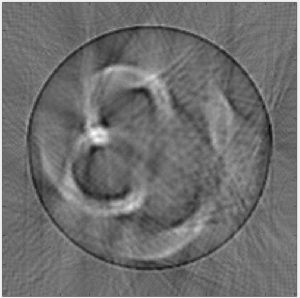Morgan Kinney, Tanner Hoppman, Jude Franklin
This week we were unfortunately unable to meet our goal of finishing the IR CT project. After completing another scan, we were able to improve our reconstruction algorithm to obtain the better image quality seen in Fig. 2, but we knew that something else still had to be off. The image is closer to being able to distinguish the phantom used, but after analyzing our sonogram in Fig. 1 we noticed that it is abnormally slanted. At the very end of the week we found the problem: our stepper motor had 200 steps instead of the correct amount of 201. The result is that the stepper motor is one step short of 360 degrees every rotation and our reconstruction gives the image in Fig. 2. With these issues resolved, we are almost certain that our next scans will give better images. We should be able to complete the scans required and move onto our next project (ultrasound) this week.
Figure 1. Image sinogram

Figure 2. Reconstructed image

Question: What happens if you more coarsely or finely sample the fan beam angles?
Answer: Fan beam angles are currently sampled at 1 degree steps. If we were able to sample them more finely, there would be no difference because the stepper motor is the limiting element for resolution since it steps at 1.8 degrees per step. If the fan beam angles were sampled more coarsely than the 1.8 degrees, they would then become the limiting factor and resolution would be negatively impacted.

I think that your sinogram was slanted because you were using 201 steps instead of 200?